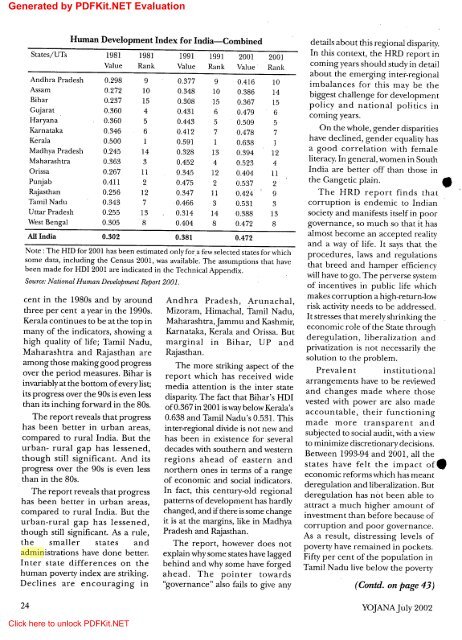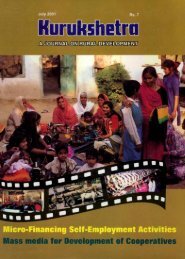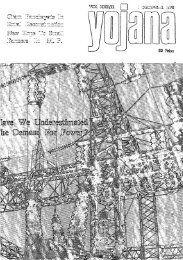Banking - Yojana
Banking - Yojana
Banking - Yojana
- TAGS
- banking
- yojana
- yojana.gov.in
Create successful ePaper yourself
Turn your PDF publications into a flip-book with our unique Google optimized e-Paper software.
Generated by PDFKit.NET Evaluation<br />
Human Development Index for India-Combined<br />
States/UTs 1981 1981 1991 1991 2001 2001<br />
Value Rank Value Rank Value Rank<br />
Andhra Pradesh 0.298 9 0.377 9 0.416 10<br />
Assam 0.272 10 0.348 10 0.386 14<br />
Bihar 0.237 15 0.308 15 0.367 15<br />
Gujarat 0.360 4 0.431 6 0.479 6<br />
Haryana 0.360 5 0.443 5 0.509 5<br />
Karnataka 0.346 6 0.412 7 0.478 7<br />
Kerala 0.500 1 0.591 1 0.638 1<br />
Madhya Pradesh 0.245 14 0.328 13 0.394 12<br />
Maharashtra 0.363 3 0.452 4 0.523 4<br />
Orissa 0.267 11 0.345 12 0.404 11<br />
Punjab 0.411 2 0.475 2 0.537 2<br />
Rajasthan 0.256 12 0.347 11 0.424 9<br />
Tamil Nadu 0.343 7 0.466 3 0.531 3<br />
Uttar Pradesh 0.255 13 0.314 14 0.388 13<br />
West Bengal 0.305 8 0.404 8 0.472 8<br />
All India 0.302 0.381 0.472<br />
Note: The HID for 2001 has been estimated only fora few selected states for which<br />
some data, including the Census 2001, was available. The assumptions that have<br />
been made for HDI 2001 are indicated in the Technical Appendix.<br />
Source: National Human Development Report 2001.<br />
cent in the 1980s and by around<br />
three per cent a year in the 1990s.<br />
Kerala con"tinuesto be at the top in<br />
many of the indicators, showing a<br />
high quality of life; Tamil Nadu,<br />
Maharash tra and Rajasthan are<br />
among those making good progress<br />
over the period measures. Bihar is<br />
invariablyat the bottom of everylist;<br />
its progress over the 90s is even less<br />
than its inching forward in the 80s.<br />
The report reveals that progress<br />
has been better in urban areas,<br />
compared to rural India. But the<br />
urban- rural gap has lessened,<br />
though still significant. And its<br />
progress over the 90s is even less<br />
than in the 80s.<br />
The report reveals that progress<br />
has been better in urban areas,<br />
compared to rural India. But the<br />
urban-rural gap has lessened,<br />
though still significant. As a rule,<br />
the smaller states and<br />
administrations have done better.<br />
Inter state differences on the<br />
human poverty index are striking.<br />
Declines are encouraging in<br />
24<br />
Click here to unlock PDFKit.NET<br />
Andhra Pradesh, Arunachal,<br />
Mizoram, Himachal, Tamil Nadu,<br />
Maharashtra,Jammu and Kashmir,<br />
Karnataka, Kerala and Orissa. But<br />
marginal in Bihar, UP and<br />
Rajasthan.<br />
The more striking aspect of the<br />
report which has received wide<br />
media attention is the inter state<br />
disparity.The fact that Bihar's HDI<br />
of0.367in 2001iswaybelowKerala's<br />
0.638 and Tamil Nadu's 0.531.This<br />
inter-regional divide is not new and<br />
has been in existence for several<br />
decades with southern and western<br />
regions ahead of eastern and<br />
northern ones in terms of a range<br />
of economic and social indicators.<br />
In fact, this century-old regional<br />
patterns of development has hardly<br />
changed, and ifthere issome change<br />
it is at the margins, like in Madhya<br />
Pradesh and Rajasthan.<br />
The report, however does not<br />
explain whysome stateshave lagged<br />
behind and why some have forged<br />
ahead. The pointer towards<br />
"governance" also fails to give any<br />
details about this regional disparity.<br />
In this context, the HRD report in<br />
coming years should study in detail<br />
about the emerging inter-regional<br />
imbalances for this may be the<br />
biggest challenge for development<br />
policy and national politics in<br />
coming years.<br />
On the whole, gender disparities<br />
have declined, gender equality has<br />
a good correlation with female<br />
literacy.In general, women in South<br />
India are better off than those in<br />
the Gangetic plain. •<br />
The HRD report finds that<br />
corruption is endemic to Indian<br />
society and manifests itself in poor<br />
governance, so much so that it has<br />
almost become an accepted reality<br />
and a way of life. It says that the<br />
procedures, laws and regulations<br />
that breed and hamper efficiency<br />
willhave to go. The perverse system<br />
of incentives in public life which<br />
makes corruption a high-return-low<br />
risk activityneeds to be addressed.<br />
It stresses that merely shrinking the<br />
economic role of the State through<br />
deregulation, liberalization and<br />
privatization is not necessarily the<br />
solution to the problem.<br />
Prevalent institutional<br />
arrangements have to be reviewed<br />
and changes made where those<br />
vested with power are also made<br />
accountable, their functioning<br />
made more transparen t and<br />
subjected to socialaudit, with a view<br />
to minimize discretionary decisions.<br />
Between 1993-94and 2001, all the<br />
states have felt the impact of.<br />
economic reforms which has meant<br />
deregulation and liberalization. But<br />
deregulation has not been able to<br />
attract a much higher amount of<br />
investment than before because of<br />
corruption and poor governance.<br />
As a result, distressing levels of<br />
poverty have remained in pockets.<br />
Fifty per cent of the population in<br />
Tamil Nadu live below the poverty<br />
(Contd. on page 43)<br />
YOJANAJuly 2002






